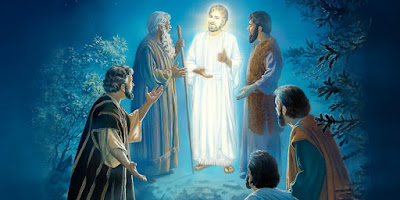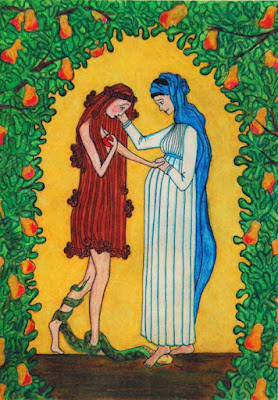The Transfiguration of the Lord, another theophany.
August 6 2019: Feast of the Transfiguration of the Lord - C
An Igbo proverb says, “Knowing but not telling it is what
kills old men. Hearing but not heeding it is what kills young men.”
The Son of Man is revealed to humanity and the voice of the
Father attests of his divine identity. That is what we feast on today. We are
celebrating a feast which is actually a theophany. Because, by definition, we
call Theophany, a visible manifestation to humankind of God or a god. It a manifestation
of God that is tangible to the human senses.
Today’s feast opens our senses, mostly our eyes (the see)
and our ears (the hear) at the intimate knowledge of Jesus true identity. For
us today, that is obvious that Jesus is the Son of God. We know it by faith.
But that was not as such obvious to the disciples. Though they followed the
Lord and witness many of his marvelous work and miracles, still, there were
some questions and many doubts. The Theophany or the Transfiguration came as a
divine seal on the Lord’s deep identity.
The event is presented as follows; we read in the account given
by Luke that, “Jesus took Peter, John, and James and went up a mountain to
pray. While he was praying his face changed in appearance and his clothing
became dazzling white…”
The Lord actually chose to appear in all his splendor and glory
to his disciples. Thus, he chose these three. Through his transfiguration,
Jesus did not become another man. In that sense we don’t talk of the
transfiguration as a transformation. Jesus is not a ‘Transformer’ in the sense
of the American fiction movie titled, the Transformers. Instead, at the
transfiguration, Jesus gave him disciples a glimpse of his glory. He showed
them his true self. Thus, Luke talks of the brilliance of his face. God reveals
himself to our humanity represented by the three Apostles. Moses and Elijah in
communication with Jesus is a proof that Jesus is the completion of the Law and
the Prophets. All that was foretold in the oracles of the prophets and all that
the Mosaic Law command are summarized and fulfilled in the person of Jesus, the
awaited Messiah.
A contrast, however is raised. Je messianism of Jesus is not
as expected by Israel, but the one long announced in the oracle of Daniel, “One
like a Son of man.”
Let us now look closely the extract of St. Luke in its context.
We can do it is a more relevant way by starting with the events before the
Transfiguration and the events after the Transfiguration. That will be of help
to see in that transfiguration the true theophanical side. In Luke 9:18-27,
Jesus questioned the disciples about his identity; what people say of him and
what themselves say of him. Starting with the rumors, they reach the
declaration or Peter’s confession about Jesus: “The Messiah of God.” It was a
kind of recognition of the Lord’s identity. But suddenly after that, the Lord
predicts his passion. The Son of Man will be in all his glory only at his
passion, death and resurrection.
The events after the Transfiguration will also teach us that
the apostles, without the master are capable of nothing, the episode of the
desperate father and the hopeless disciple (Lk 9:37-42). Jesus is the one who
has all authority over every spirit.
Then the Transfiguration itself as narrated by Luke. We read
that at the Mountain with his three disciples, he gave them to see the splendor
of the Messiah: His face shined, his clothes became dazzling white. They also
saw two men in their splendor, Moses and Elijah, the pillars of Judaism. Then lost
in that show of glory, the Apostles, through Peter can only say few things, that
themselves do not even know, “Master, it is good that we are here; let us make
three tents, one for you, one for Moses, and one for Elijah.” And the most
beautiful part of the Transfiguration, what they hear: from the cloud a voice
confessing the Lord’s identity and giving a recommendation of what to do: “This
is my chosen Son; listen to him.”
We read in the preceding verses that Jesus asked the rumors
about him and Peter confessed who they think he is. But then, God himself says
who he is. A says goes that the most important is not what people say of
someone. But what he says of himself. That is what we should believe the most.
The message of the transfiguration is as well simple and can
constitute a challenge to each one of us. We are given firstly to know Jesus as
the Son of Man, the chosen one in whom the Father is well pleased. Then the
challenge is the recommendation: “Listen to him.”
We are told that it is not just enough to know who Jesus is.
But after knowing him, after discovering his inner identity, to take time to
listen to him. By listening to the Lord, we discover the will of God in him and
the will of God on our lives, and therefore we avoid confusion such as the one
Peter and his companions made.
Many people today, have lost the capacity of listening. We listen
to many things, music, gossips, bad news, evilness. But when it reaches to
listen to the Lord, we seem not hearing nothing. We live in a deafening world
where people prefer listening to themselves than to listen to others and to
God. God revealing himself to us, exhorts us to open our ears to him. That is
the message of this theophany. That it not enough to know the Lord, but we will
do well listening to him and putting into practice his words.




Comments
Post a Comment